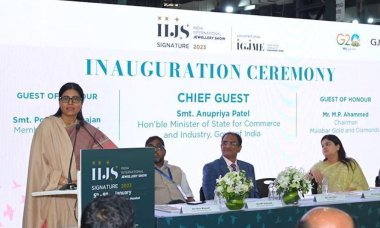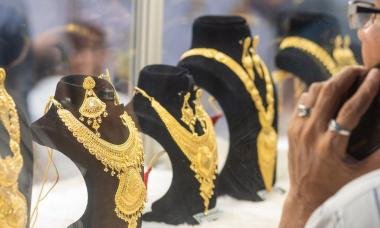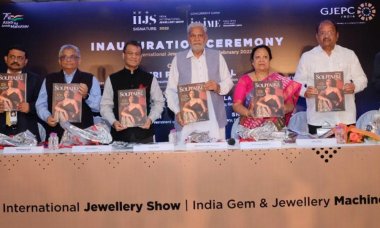By Cynthia Unninayar
Given the importance of coloured gemstones in fine jewellery, the Gems & Jewellery Promotion Council of India (GJEPC) recently launched its first Mines to Market event for coloured gems. It brought together miners, retailers, marketers, and designers from across the globe to discuss many of the aspects of the gem and jewellery trade.
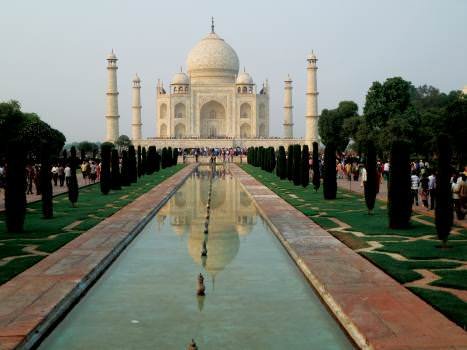
|
| The Taj Mahal, built by Shah Jahan starting in 1632 as a mausoleum for his third wife, perfectly illustrates the skills of gemstone inlay and carving dating back hundreds of years. |
With its long history of coloured gemstone cutting and manufacturing, the Indian city of Jaipur was the perfect venue for the firstever Mines to Market conference devoted to coloured gems. Organized by the GJEPC, the two-day event was attended by more than 350 people who came to hear discussions by some twenty speakers on various topics relating to the gemstone pipeline.
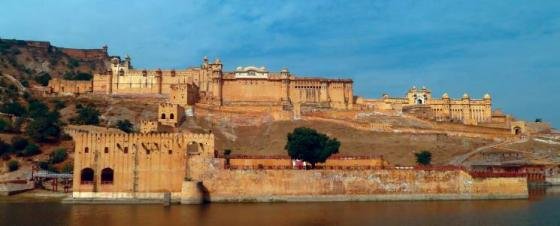
|
| The famed Amer fort, whose origins date back to the 10th century, is a main tourist destination in Jaipur, India’s main city for coloured gemstones and jewellery. |
India’s Gem and Jewellery Industry
“Colour is intrinsic to the culture of India and just a glance around is sufficient to prove how imbued, with a myriad of hues, are the lives of the people of this vast and diverse nation,” stated Rajiv Jain, GJEPC chairman, in his opening address. “More importantly, this country has had a long and deep-rooted connection to coloured gemstones throughout the ages. From the earliest known jewellery found in India, to the world-renowned collections of the maharajahs, to modern times, the jewellery made and worn here has always been resplendent with the shades of many coloured gemstones.”
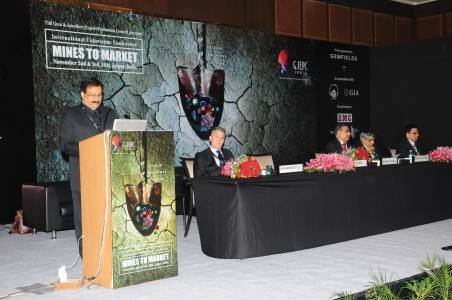
|
| GJEPC chairman Rajiv Jain gives the welcoming address at India’s first ever Mines-to-Market conference on coloured gemstones. On the dais are Ian Harebottle, Saurabh Chandra, Sanjay Kothari, and Rajkumar Nagpal. |
The coloured stones processed in India encompass virtually the entire gemstone and jewellery pipeline. The sector employs close to one million people, with 100,000 in Jaipur alone. During 2010-11, India exported coloured gems worth US$315.22 million, an increase of 9.92 percent over 2009-2010, with 20 percent of exports going to the USA and Europe. While exports of coloured gems are relatively minor compared to India’s total exports of US$43 billion, the GJEPC feels there is potential for strong growth, especially in emerging markets, and that exports will increase significantly over the next three years. Jain also stated that India is “perhaps the only country in the world, which is a complete centre in the gems and jewellery field, with a strong manufacturing base for diamonds, coloured stones, and jewellery, in both plain metal and studded.” The nation is also one of the world’s fastest developing marketplaces with a rising middle class.
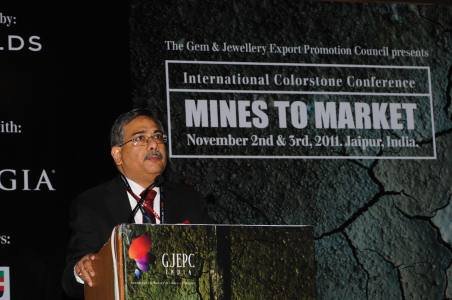
|
| Saurabh Chandra explains measures by the government to make India the global trading hub for gemstones. |
In his speech, Saurabh Chandra, Additional Secretary and Financial Adviser, Ministry of Commerce and Industry, Government of India, discussed measures to make India the global trading hub for gems and diamonds along the lines of Belgium, Israel, and Thailand. The government is thus drafting and implementing a comprehensive action plan to support new marketing endeavours. He also stated that import duties on both rough and polished gems have been abolished, which has thus resulted in increased trade of all types of gemstones.
Topics of Discussion
In the keynote address, Alberto Milani of the Italian jewellery brand, Buccellati, explained that the main competition for jewellery is not other brands so much as it is other luxury products and experiences, such as vacations and hotel stays. Purchasing a piece of jewellery should be a luxury experience, not just a luxury product. He stated that the high and low ends of the market are still doing fine, while the middle is being crushed.
Moderated by Yianni Melas, the conference covered a wide range of topics, from the world’s gem resources and mining, to ethical and sustainability issues, to jewellery manufacturing and branding.
Among the many speakers (a complete list and summary of each speaker is available at www.gjepcindia.org), Richard Hughes (Sino Resources Mining) talked about the hope that coloured stone mining offers people in terms of livelihoods. He also stressed the importance of creating an emotional link to coloured gems in a way that De Beers has done for diamonds.
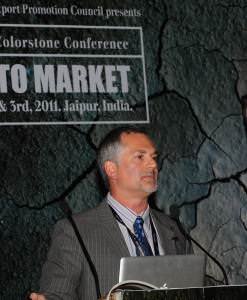
|
| Edward Boehm, RareSource, talks about the world’s gem resources and the importance of sustainability. |
Edward Boehm (RareSource) also felt that gems are largely about people, and marketing them is not just about romancing the stone but also means providing accurate technical information to the consumer. There are 47 primary coloured gemstone producing nations in the world, and 80 percent of gems come from Artisanal and Small-Scale Mining operations (ASMs), with 90 percent of ASMs located in developing and emerging nations. Boehm also stressed the importance of ethical mining and fair trade.
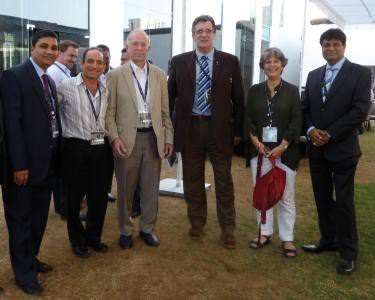
|
| Conference delegates, left to right: Manoj Dhandia, Steve Bennett (behind), Glenn Lehrer, John Saul, Warren Boyd, Mrs. John Saul, and Dinesh Malpani. |
John and Mark Saul (Swala Gem Traders) provided insight into the geology and gemstones of East Africa, most of which are traded in Arusha, stating that 90 percent of mining is ASM, with 10 percent by large corporations such as TanzaniteOne, Gemfields, and Gemfinder. They also stressed the importance of creating partnerships with local miners to benefit their communities. Ethical considerations in relation to workers’ conditions and mining activities were also discussed by Robert Weldon, GIA, who used the example of an ametrine mine in Bolivia.
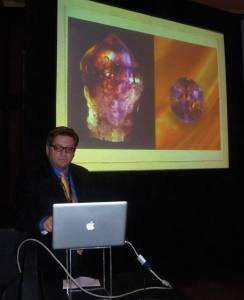
|
| Robert Weldon (GIA) describes ethical mining conducted by an ametrine mine in Bolivia. |
Organized corporate mining was detailed by Ian Harebottle (CEO, Gemfields) in an impassioned speech on the need for change in the gemstone industry.
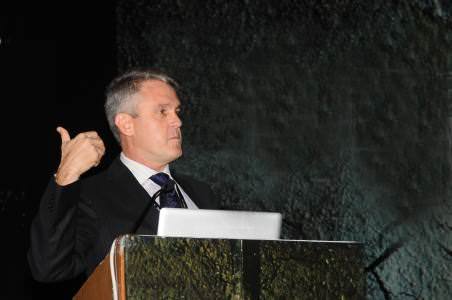
|
| Ian Harebottle gives a passionate speech about the need for change in the gemstone industry. |
Harebottle also talked about Gemfields’ emerald and ruby activities in Africa, as well as how the company invests in technology and mechanization, which lowers production costs. Harebottle went on to stress the importance of giving back to local communities, and what Gemsfields is doing in this regard.
Gavin Pierce of Richland Resources (formerly TanzaniteOne) recounted the tanzanite story and his company’s use of modern methods and mechanization. He also summarized the company’s community involvement, indicating how organized mining can provide greater returns for both the company and local governments as compared to the fragmented ASMs, which use primitive methods, and have poor environmental records and working conditions. He added that TanzaniteOne produces 2.4 million carats of tanzanite per year, and that there is still an estimated 50 million carats in the ground, or enough for the next 20 years. Observations on upcoming markets for gemstones were provided by George Shen (California Gemological Institute), speaking about opportunities to be had in China’s gems and jewellery market today, and Lixin Yang (Gemological Association of China), who spoke on the development of China’s jewellery industry.
Wong Chi Ming (Magfrey Jewelry) discussed the importance of branding in China, stating that the “Chinese like things that give a nod to the past while being modern and forward thinking. As their wealth increases, fine jewellery is the perfect complement to their new position in the world.”
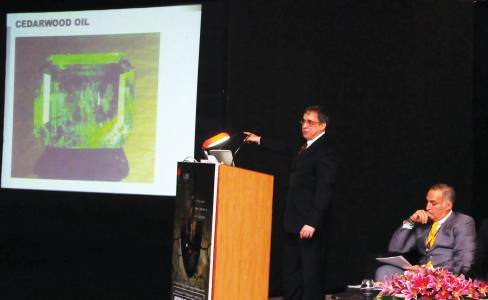
|
| Andrew Lucas, GIA, discusses gem treatments and the importance of disclosure. At right, seated, is conference moderator, Yianni Melas. |
Gem treatments were discussed by a number of speakers: Richard Hughes (Gem & Jewelry Institute of Thailand) on corundum enhancements; Helmut Zimmermann, (Herotron E-Beam Service), on irradiation of gemstones; and Andrew Lucas (GIA) on treatments and disclosure. Other topics dealt with technical production and lapidary methods, including speakers Eddie Bell (Rio Grande) on the challenges and opportunities in producing high quality jewellery in India, and Glenn Lehrer who showed images of his gem-cutting artistry. The conference ended with issues relating to media and marketing opportunities discussed by Hamilton South (HL Group) on storytelling for consumers, and Candy Andrew Lucas, GIA, discusses gem treatments and the importance of disclosure. At right, seated, is conference moderator, Yianni Melas. Pratts Price of Vogue.com, who spoke on using media to reach consumers. Steve Bennett of GemsTV gave a lively talk on ethical issues and how he romances gemstones on television.
In his concluding remarks, Rajiv Jain stated that the two-day conference was an eyeopener for the coloured gemstone industry in Jaipur, and that local players showed immense enthusiasm. “We need to take this forward from here and organize a similar coloured gemstone Mines to Market conference in Thailand and China. This has to be a continuous process since we need to grow as an industry worldwide, and this is the first step towards the revival of the industry.”


